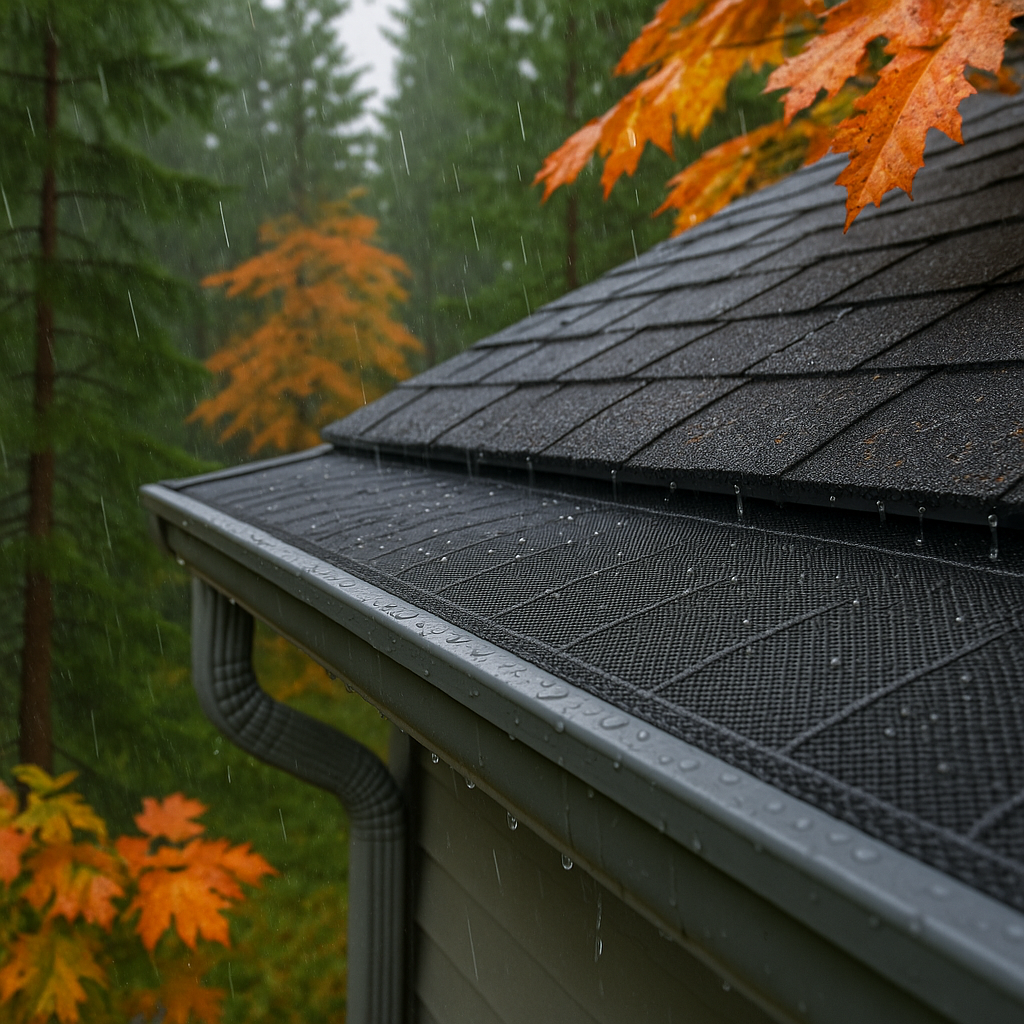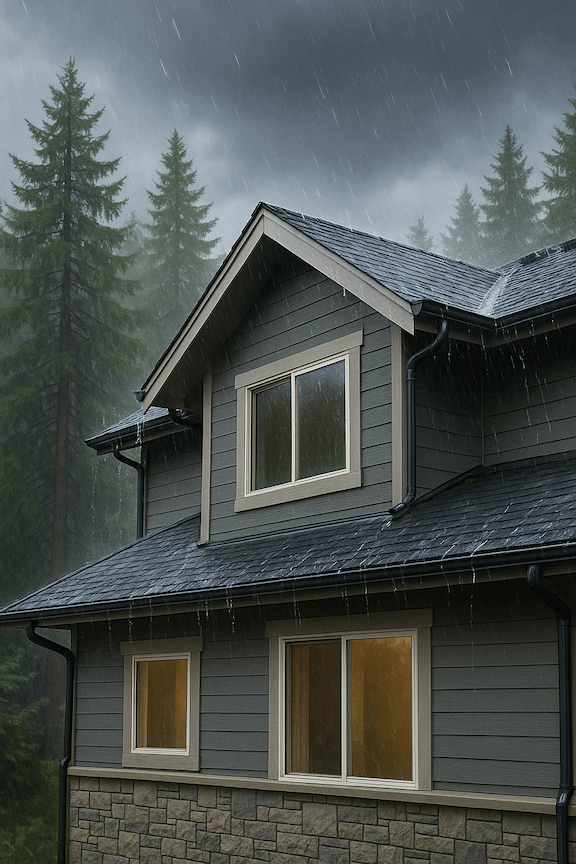Oregon’s forests are stunning. But if you own a home here, you know those beautiful trees are also a pain, especially for your gutters.
Pine needles, maple leaves, and heavy rainfall come together to clog gutters faster here than in most places. Once your gutters back up, it’s not just a messy inconvenience. It’s water damage waiting to happen.
That’s where gutter guard installation becomes a game-changer. Think of them as your gutter’s personal bodyguards, shielding against clogs, cutting down cleaning, and helping your system last longer through Oregon’s toughest weather.
A Closer Look at the Oregon Gutter Challenge
Gutters in Oregon face a triple threat. And it’s not just about falling leaves. It’s about the timing, shape, and volume of debris that hits all at once.
Pine Needles
Don’t let their size fool you. Pine needles are one of the worst offenders when it comes to gutter clogs.
Their slender, flexible shape lets them lie flat and slip past basic screens. When it rains, they mat together like thatch, forming dense blockages. A single pine needle impacts water flow at the downspout. If you multiply that by hundreds, you’ve got a serious clog.
Douglas-firs are common here, and they shed constantly. Wind can carry their needles from across the street into your gutters. Once inside, they hold moisture, promoting moss and rot even before winter hits.
Maple Leaves
Bigleaf maples are native to Oregon and known for their broad, dramatic fall leaves. However, those leaves are not gutter-friendly.
They plaster themselves over gutter openings, especially after the first heavy rain. Wet leaves stick to everything, blocking screens and stopping water from draining properly. The City of Portland even runs a Leaf Day program from November through mid-January just to keep storm drains clear. Your gutters deal with the same flood of foliage.
Heavy Rain
Oregon’s wettest months, November, December, and January, drop more than 5 inches of rain per month. That means all that debris gets pushed down fast. When leaves and needles are already blocking the flow, water has nowhere to go. It spills over the sides, soaks into your siding, or even backs up under shingles.
How Gutter Guards Work as Your First Line of Defense
Gutter guards aren’t complicated. They let water in and keep most debris out.
Gutter guards work, especially in Oregon. But only if you choose the right type for your trees and roof. When matched properly:
- They block leaves, needles, and even shingle grit.
- Water flows through the screen, reducing overflow during storms.
- You get less standing water, which means less rot, less mold, and fewer pests.
A well-fitted guard turns your gutter system from reactive to proactive. Instead of dealing with problems, you’re preventing them.
Why Oregon Homes Win With Guards
Beyond blocking debris, guards give you real, long-term benefits that matter, especially when you live in a place like this.
Fewer Cleanings
No one enjoys scooping mushy leaves out of gutters. Without guards, most Oregon homeowners need cleaning twice each fall. With guards, that drops to once a year, maybe even less. That’s time saved, ladder risk avoided, and fewer calls for gutter cleaning services.
Extended Gutter Lifespan
Clogged gutters get heavy. The weight from soggy leaves and pooled water bends brackets and stresses the system.
Guards keep debris out, so gutters stay lighter and last longer. You also avoid corrosion from trapped water sitting inside for weeks.
Superior Water Management
Gutter guards help your system stay open and moving, even during back-to-back downpours. Instead of overflowing, water follows the right path to your downspouts, keeping your siding, foundation, and landscaping safe. That control matters most if you’ve got a sloped yard or clay-heavy soil, where drainage problems can quickly turn into serious erosion or moisture damage around your home.
Choosing the Right Gutter Guard for Oregon Debris
There’s no one-size-fits-all solution. The type of guard that works best for your home depends on what’s falling from your trees and how your roof handles rain.
Mesh Screens
- Great for maple-heavy areas where the debris is larger.
- Easy to install, good balance between price and performance.
- Best for homes needing basic gutter screen installation.
Micro-Mesh Guards
- Top pick for pine needles and fine debris.
- Stainless steel versions resist rust and sagging.
- Ideal for installing gutter guards on homes surrounded by fir, cedar, or spruce.
Reverse Curve / Surface Tension Guards
- These are engineered for maximum water intake.
- Debris rolls off the curved edge while water clings and drops in.
- Best for roofs with steep pitches or heavy rainfall zones.
No matter the type, professional installation makes a big difference. That includes checking your existing gutters for slope issues, leaks, or incorrect pitch.
The Power of a Complete System: Guards + Seamless Gutters
For real protection, pairing gutter guards with seamless gutters in Oregon makes a noticeable difference. Seamless systems are cut specifically for your home, so there are no joints where water can leak or debris can catch. The interior stays smooth, which helps water move efficiently, even during heavy rain.
When combined with properly installed guards, this setup cuts down on maintenance, reduces blockages, and helps you avoid bigger issues like wood rot or foundation damage over time.
We Can Help You Withstand Oregon’s Leaves and Pine Needles
Oregon’s forests aren’t going anywhere. And that’s a good thing. However, you shouldn’t have to climb a ladder every other weekend to deal with the fallout.
Gutter guards give you breathing room. They stop pine needles from weaving into clogs, keep maple leaves from plastering your gutters shut, and help your home weather the storm.
At Gutter Empire, we install seamless gutters built for Oregon’s heavy rain and tree debris. If your home needs a serious upgrade, we’re here to help. If you are looking for gutter guard installation services near you, our team offers expert help. We can help you protect your gutters and your home season after season.
If you would like a better setup, you can contact us at (971) 777-9899 to set up a consultation or get a free estimate here. We’ll design a system that withstands Oregon’s elements and lasts all year.
Key Takeaways (with footnotes/citations)
- Oregon’s tree cover creates constant gutter blockages. Pine needles and maple leaves combine with the region’s heavy rainfall to clog systems fast, especially from November through January when rainfall exceeds 5 inches per month on average.【National Weather Service Portland Climate Data†https://www.weather.gov/media/pqr/climate/ClimateBookPortland/pg75.pdf】
- Blocked gutters cause serious water damage. When rainwater can’t drain, it spills over and seeps into siding, fascia, and foundations, increasing the risk of wood rot and soil erosion.
- The City of Portland dedicates an entire program—Leaf Day—to managing leaf debris. Home gutters experience similar overload during late fall, making guards a practical preventive measure.【City of Portland Leaf Day Program†https://www.portland.gov/transportation/maintenance/leaf-day】
- Gutter guards reduce cleanings and extend gutter lifespan. By keeping pine needles and wet leaves out, guards minimize stress on brackets, lower corrosion risk, and cut annual maintenance in half.
- Seamless gutters + guards offer the best long-term protection. Seamless systems remove weak joints, ensuring consistent water flow even in Oregon’s heaviest storms, while gutter guards prevent clogging at the source.


